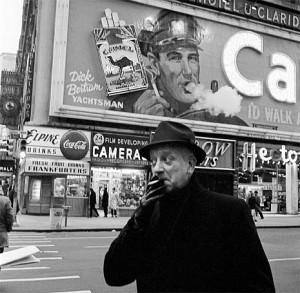
The endless breath of smoke. The unexpected blink. The sudden nod.
Visit the “Eternal Moments” gallery of cinemagraphs by Ana Pais for some stunning moments of the uncanny. The portfolio opens up with a citation from Barthes’ “Camera Lucida” that reads: “What the Photograph reproduces to infinity has occurred only once: the Photograph mechanically repeats, what could never be repeated existentially.” Such mechanical forms of repetition are particularly striking when they refer to organic life. These illusory images blur the lines between movement and still images — analogues for life (movement) and death (still) — in a way that generates a spectacularly uncanny effect…mostly because of the intellectual uncertainty that arises when our expectations between visual stasis and activity are foiled.
Cinemagraphs like these are fascinating art experiments, using “animated .gif” techniques. Animation is itself an uncanny artform, because it literally “brings to life” still frames — and while this may in some ways be more apparent in stop-motion techniques (where, I would argue, the jitter produced by editing has as much to do with the uncanny affect as the conceptual “animation” of inanimate objects we see), digital art is offering numerous new ways to trick the eye in uncanny ways.
But when I first saw the striking image above by Pais, my mind went elsewhere: from optical illusions to advertising. I was reminded of automaton-like advertisements that use similar tactics. Like the famous Camel cigarettes billboard that actually blew smoke rings — the one pictured in this shot below from the NY Times is a classic (also see the images and posts at Shorpy.com for more).

There have been some creative reworkings of these billboards that smoke, but they always seem to have to do with life and death, avowed and disavowed by machinery. These are automatons, harbingers of death in a monstrously large scale. While I don’t believe they are used anymore for advertising tobacco (I could be wrong), I recently read of the Avera “Why I’m Alive” campaign which used the smoking billboard in a clever way — to call attention to a smoldering car accident. AdWeek reported last September that the billboards were pulled for being a distraction, because people believed the sign was actually on fire and called 911. But — to come full circle — they’re still being used in a new media advert on their website at whyimalive.com.
The Averna ad campaign is really interesting to me because “Why I’m Alive” is not only a good slogan for an emergency assistance company — in which profiles of survivors are used to personalize their life-and-death experiences — but also a direct expression of one of life’s universal questions: “Why AM I alive?” There is a subtle reference to the supernatural in this, for the “agency” of creation is aligned with the advertising agency.